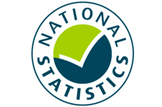UK economy grows 0.2 per cent in February as Brexit stockpiling provides a lift

New official data published today has revealed that the UK economy had a better-than-expected February as GDP grew 0.2 per cent month-on-month despite heightened Brexit uncertainties and weakened global growth.
There was a marked lift to activity in February in the form of Brexit-fuelled stockpiling boosting output in the manufacturing sector, the Office of National Statistics said.
Annual GDP growth jumped to 2.0 per cent in February, which was the best performance since November 2017 and up from 1.5 per cent in January and a low of 1.1 per cent in December.
This was helped by the fact that GDP had fallen 0.3 per cent in February 2018 as severe weather started to bite.
The underlying performance of the economy also looked marginally better with GDP growth at 0.3 per cent in the three months to February.
The ONS also reported that the UK trade data deficit narrowed modestly to £4.9bn in February after jumping to £5.3bn in January from £3.4bn in December and £3.0bn in November. Exports edged up 0.1 per cent month-on-month in February while imports dipped 0.7 per cent.
Output in production and manufacturing rose for the second month in a row, with manufacturing at its highest level since April 2008, the ONS said.
The ONS said production industries expanded by 0.2 per cent in the three months to February 2019. This was the first positive three-month growth since October 2018.
However, Rob Kent-Smith, head of GDP at the ONS, said growth “remained modest”.
“Services again drove the economy, with a continued strong performance in IT. Manufacturing also continued to recover after weakness at the end of last year with the often-erratic pharmaceutical industry, chemicals and alcohol performing well in recent months,” said Mr Kent-Smith.
And March looks to have been a difficult month for the economy.
Notably, the purchasing managers reported that the services sector contracted in March for the first time since July 2016 and also found construction activity contracted marginally. However, the purchasing managers reported manufacturing activity spiked to a 13-month high in March.
The ONS said there had been external evidence “that some manufacturing businesses have changed the timing of their activity as we approached the original planned date for the UK’s departure from the European Union”.
“Although the ONS does not routinely collect detailed data on the reasons behind the behaviour of businesses, as part of our survey validation we have found some qualitative evidence that supported this view but were unable to quantify its impact,” it added.
On the back of the publishing of today’s figures, Howard Archer, chief economic advisor to the EY ITEM Club, said the Bank of England will most likely respond by cutting interest rates, while there would also likely be some easing of fiscal policy.
He said: “On balance, if a second quarter “no deal” UK exit from the EU occurred, we suspect GDP growth would likely come in at 0.8 per cent in 2019 and 0.5 per cent in 2020 — with the economy likely suffering stagnation over the latter months of 2019 and start of 2020.
“The Bank of England is clearly going to sit tight on interest rates until there is greater clarity on the Brexit situation and it can see how the economy is being affected. Indeed, there is a very real possibility that the Bank of England will keep interest rates at the current level of 0.75 per cent through 2019.
“If there is a UK exit from the EU with a “deal” during the second quarter, it is possible that the Bank of England could raise interest rates from 0.75 per cent to 1.00 per cent in November if the economy is showing improvement helped by reduced uncertainty. Even if this is the case though, the MPC could prefer to hold off acting for longer as it may well want to see sustained evidence of stronger UK economic activity.
“It is also possible that the Bank of England could raise interest rates later this year if there is ultimately a long Brexit extension and the economy shows signs of picking up from its late-2018 / early-2019 weakness.
“Further out, we expect the Bank of England to raise interest rates twice in 2020 as it looks to gradually normalise monetary policy and the economy is likely firmer if it has left the EU with a “deal”.
“Should there eventually be a “no deal” UK exit from the EU – be it during the second quarter or after a delay - the growth, inflation and interest rate outlook will potentially be very different. “We strongly lean towards the view that interest rates would be far more likely to be cut than increased if there is ultimately a “no deal” Brexit.”






